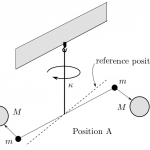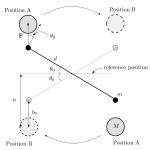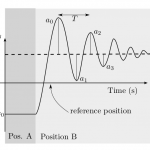With a set-up known as the Cavendish experiment, students estimate the gravitational constant G from the attraction between masses. This experiment is currently being converted from a traditional “paper-handout” experiment, to a fully developed Lablet activity.
A pair of masses is suspended from a torsion balance. When two large masses are introduced to attract the masses on the torsion balance, the system oscillates until a new resting position is achieved:
- Side-view ofthe Cavendish experiment
- Top view of the same setup
- Oscillations of the torsion balance
A series of derivations guided currently by a paper hand-out — but under construction as a lab activity — shows how the observations of amplitude and phase of the oscillations lead to an estimate of G, the gravitational constant. These small oscillations are projected on a scale by a light reflecting from a mirror attached to the torsion balance.
Below is a video of the light on the scale, but played at an increased frame rate:
Until the advent of Lablet, this light was tracked manually and in real time (for hours) by students with a stopwatch. With the aid of the motion analysis module, and a newly developed auto-tracking module, the location of the light as a function of time is recorded, and can be automatically obtained:




